Are you planning family holiday in Italy, then you must visit Venice and read our guide Venice with kids.

About Venice
Venice is at the top of the Adriatic in Italy’s north east and is the capital of the Veneto region. The city is made up of 118 small islands separated by canals, and most of them are linked by a total of more than 400 bridges. The islands that make up the city are clustered together away from the mainland in the Venetian Lagoon – an enclosed bay formed by the merging estuaries of the Po and the Piave rivers. According to the 2018 census, the Veneto region has a population of about a quarter of a million Out of that population, 50,000 live in the historic city of Venice.
As a family-friendly destination, Venice scores high for children above toddler age for its lack of roads and vehicle traffic and its fun-to explore ways and squares.
During our travels through Italy, we Discovered Chioggia, which is known as Little Venice and its a great place to explore.
About this article
We have described things to do and see in Venice and we tell you what we particularly liked about them.
We have written it so you can see in advance how to get the best fun and experience with your time here, and we hope to help you avoid common risks which travellers can sometimes come across.
After describing attractions, we give indicative prices, and if there is an official website for the attraction, then we give a link.
Brief History of Venice
In the Dark Ages of the fifth century AD, the Byzantine Empire was now retreating in the north from marauding Central European barbarians. The city state of Venice was founded as a refuge, protected by swampy marshland, for the last remnants of the Christian Byzantine Empire here on the north side of the Mediterranean.
Venice was favoured by the Roman Church as a trading port with Constantinople (now Istanbul) and other Byzantine ports across the Mediterranean on the land routes from the Far East to Europe. Over nearly a thousand years, Venice grew enormously rich and powerful on trading silk and spices. In the mid fifteenth Century, the Islamic Ottoman Empire defeated the Christian Byzantines in Constantinople, however Venice held a strong enough position to form new trading alliances with the Ottomans, and grew even richer. But the end of Venice’s peak time was now approaching.
In the sixteenth seventeenth and eighteenth centuries Venice’s wealth and power declined. Now trade with the New World, and new sea routes with India around the African Cape meant that the centre of European power shifted to the Atlantic states of Britain, France and Spain,
Venice was conquered and looted by Napoleon at the end of the eighteenth century and then changed hands several times between the French and the Austro-Hungarian empires before eventually becoming part of the new unified Italy at the end of the nineteenth century.
This literally and figuratively rich history, together with its unique site combine to make Venice one of the jewels of European tourism.
Fun Venice Facts for Kids
Our kids love fun facts, so here are a few for yours:
- Venice has 417 bridges, 72 of which are privately owned.
- Houses in Venice are numbered according to districts not along streets. This makes it difficult to find a house by its address, so it is usual to navigate by landmarks and monuments.
- About 400 gondoliers typically wearing striped tops operate a similar number of gondolas.
- Because the gondolas are powered by a single oar on one side of the boat only, the shape of the gondola is not symmetrical So it is unlike almost all other boats worldwide. The boat is curved so that it travels straight, despite its offset means of propulsion.
- Venice has 177 canals of which the Grand Canal is the largest of all, splitting the city into two.
- Venice is sinking at the rate of 1 to 2 millimeters every year.
- The town is flooded most years in the winter, and scientists believe it will be flooded permanently by 2100
- The population of residents has halved in just 50 years, and experts predict that almost no one will live there by 2030.
- The world’s first public casino opened in Venice in 1638.
- Eight years later in 1646, a baby girl was born here who would become the world’s first woman graduate (Elena Lucrezia Corner)
Things to do in Venice with Kids
Explore the Grand Canal on the Vaporetto
This is one of the best ways to experience Venice. There is no feeling like riding with your kids the length of the great watercourse that arcs across the heart of Venice. This ride is like no other. It will take you past the glittering palaces that belonged in the Gothic and Early Renaissance periods when Venice was one of the richest cities in the world. But you will not be the only ones on the Vaporetto Waterway. The channel is also used by water taxis, police boats with sirens, cargo barges, private launches, delivery boats, as well as kayaks. It all makes for a lively scene on the water.
Vaporetto Line 1 will take you under two of the common bridges in the city – Rialto and Accademia, and to Piazza San Marco where you will see the Doge’s Palace and St. Mark’s Basilica.
Pro tip: For the best views of the Grand Canal, take your place at the back of the Vaporetto, during clear weather.
Visit Piazza San Marco
Head over to one of the most beautiful public spaces in the world at Piazza San Marco or St. Mark’s Square. Chill here with your kids for a few hours as you admire the beautiful architecture of the Campanile (Bell Tower), the Basilica San Marco, (Cathedral) Palazzo Ducale (Doge’s Palace), and theTorre dell’ Orologio (Clock Tower).
Soak up the atmosphere around the place as your kids chase pigeons or enjoy the antics of the numerous street performers.
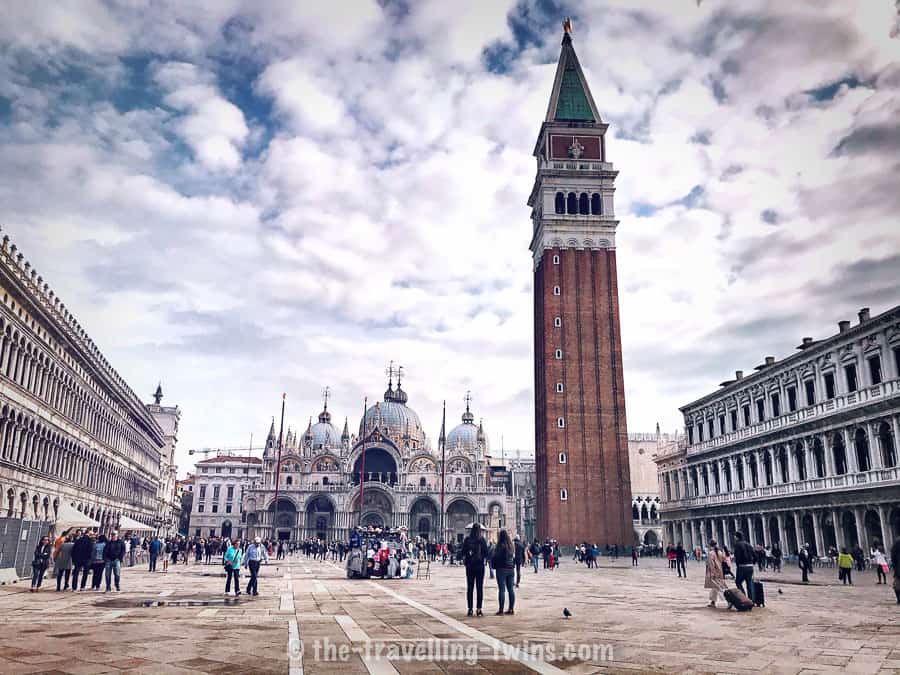
Pro Tip: Cafés lining St Mark’s square are extremely pricey, so be prepared for this before taking a seat.
Our kids love chasing pigeons but they also enjoyed the literally rich histories of the Basilica San Marco and Doge’s Palace. These buildings hold some interesting secrets and The clock Tower May only be visited by prior booking online (link below)
- Website
- Google Map Location and How to Get There
Enjoy the views to and from San Giorgio Maggiore
The Palladian church of San Giorgio Maggiore is located on Its own island facing the Doge’s Palace across the Lagoon. The view of this island from St Mark’s is well known, but it is well worth catching a water bus across to the San Giorgio Island. You can ascend the Campanile by lift for only E3 and look back at St Mark’s and the lagoon from the top. This gives you a view of the whole of Venice like no other.
The church is a restrained design by Palladio much less flamboyant than most of the Baroque churches of the city and the island itself is a similarly relaxed escape from the crowds in St Marks. You may not have to queue at all for the lift up the campanile.
- Website
- Google Map Location and How to Get There
Collect Venetian Winged Lions
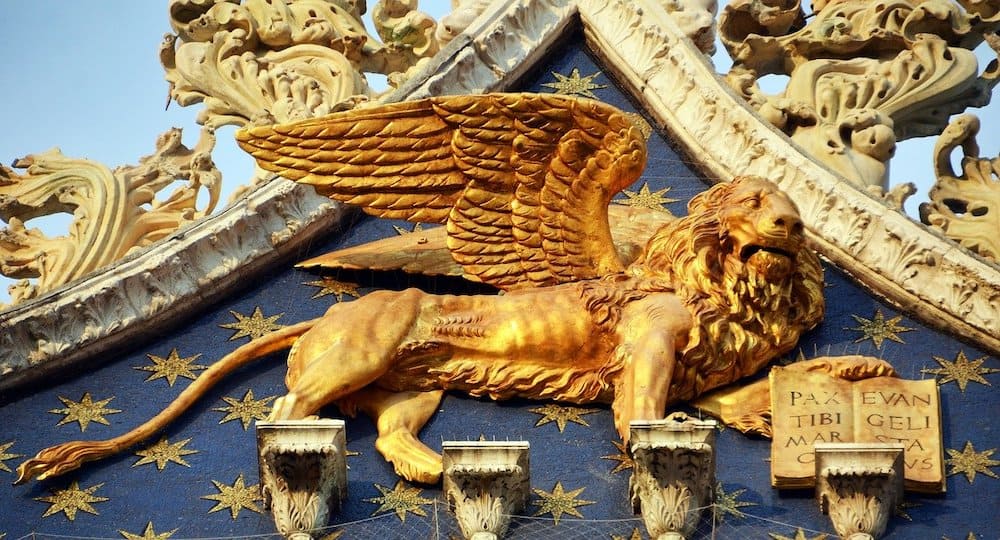
The Piazza San Marco is home to the iconic winged lion. He stands on top of a stone column broadside onto the waterfront outside the Doge’s Palace. The lion is a symbol that originated from Ottomans in what is modern-day Turkey and from where Venice gained much of its wealth. It was initially a pagan symbol but later was adapted by Christian as the symbol representing St. Mark.
The city of Venice is dotted with these symbols, particularly in squares and churches but also on flags and even the local bank’s logo. Spotting the winged lion on buildings, bridges, and doors can be a fun way to teach your kids the history of the city.
Fun fact about the symbols is that you will notice a bible under the lion’s feet. In some statues, the bible is open and in others it’s closed. A closed bible means that the statue was made when the city was at war, while the open book is a symbol of peace.
I had read about finding Winged Lions on another blogpost, and adopted the idea for us. It worked well. When girls were bored with constant walking I asked them to spot the Lions and they loved this play.
Explore the Rialto Market
One of the best ways to soak up the culture of a city is by touring its markets and trying fresh foods.
The Rialto Market is one of the largest markets in the city, and boasts an incredible mixture of sights and smells from the Vento region and the sea. Our girls (and their father) never tire of fish and seafood markets with their mysterious collage of textures colours and smells. There are always a few mischievous cats and birds there too to enliven the scene. As this is Italy, you will also find here mouth-watering dried meats, cheeses and mushrooms from the mainland.
The market is open daily from 7:30 Am to 13:00, but the fresh food market stays closed on Sundays while the fish market closes on Mondays.
Tour a Gondola Workshop
Gondolas are the iconic form of transport in Venice, with more than 400 constantly cruising the narrow waterways between the islands. These gondolas of course need repair and maintenance, There are five gondola workshops in Venice dedicated to building and maintaining the famous and invaluable boats. and this makes for a fascinating visit. Thankfully, the workshop at at Squero San Trovaso in Dorsoduro is open to the public, so you can watch as craftsmen work on the boats.
When you look at gondolas in use you will see a strangely carved rowlock holding the single oar. This is the Forcola. It is detachable and will have been custom made especially for the individual gondolier, depending on his size and weight. Of course carving the forcola and the oar (rema) is a specialist craft. You can visit one of the craftsmen here:
Succ. G. Carli di Paolo Brandolisio Costruzione Forcole e Remi
Ramo, Calle Rota, 4725, 30122 Venezia VE, Italy
+39 041 522 4155
Tour colourful Burano Island
Burano offers a different experience outside the lagoon. The number 12 Vaporetto will take you straight to the island. Houses here are painted in vibrant colors and will effortlessly put a smile on your faces.
Burano is a great place to take those family photos. There is a lace museum here as well as little shops.
Pro tip: There is a small children’s playground on Burano Island where your kids can enjoy a great time.
Have a coffee while your children play in the Campi
Venice is known for its hundreds of small squares linked by a maze of tiny streets and each square (Campo) has an ancient cistern where kids children can run around and explore.
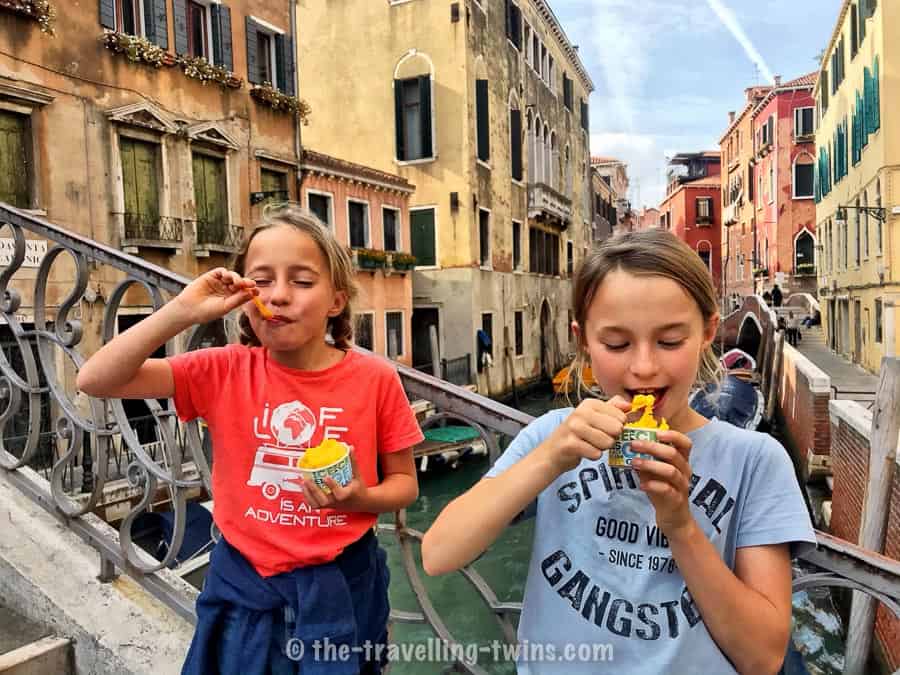
The campi vary in sizes, with larger ones typically featuring cafes and restaurants with external tables and seating. If you want to keep exploring, just pick up an ice cream and carry on. Our children have milk intolerance, and we found that many of the ice cream vendors sell lactose free sorbets, even if they don’t display them on the front stand.
Try Traditional Venetian dishes
There are plenty of traditional Venetian dishes that you should try when in Venice. Everyone knows that pasta and pizzas come from Italy, but you can have those anywhere in the world.
The best way to try the Venetian food is by going for aperitivo snacks. These are equivalent to Spanish tapas, and you will find them in local bacari wine bars, where they are displayed on glass display counters. The only problem is deciding which snack to order.
Cicchetti is also among the most popular foods in Venice. These are small dishes comprising fried food stuffed with meat. There are different types of Cicchetti around Venice, and the best way to sample them is by visiting bacari bars.
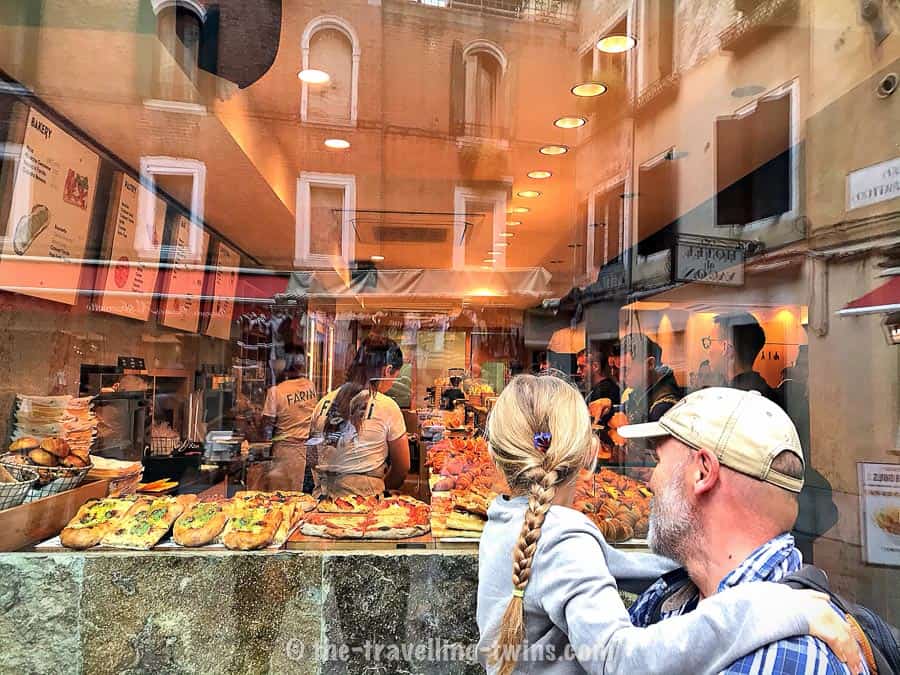
Last but not least, you can try tramezzini, which is also a popular Venetian food eaten instead of or alongside Cicchetti with a spritz or glass of wine. Tramezzino is simply slices of white bread without crust loaded with fillings like egg, mayonnaise, prawn mayonnaise, artichokes, and ham and cheese.
Create a Venetian Mask
In February every year in Venice, an event called Carnevale (Equivalent of Rio de Janeiro’s Carnival) is celebrated by over 3 million people. It is a tradition that dates back to the twelfth century when residents of the city celebrated a victory of the Venetian republic by singing and dancing in the Piazza San Marco.
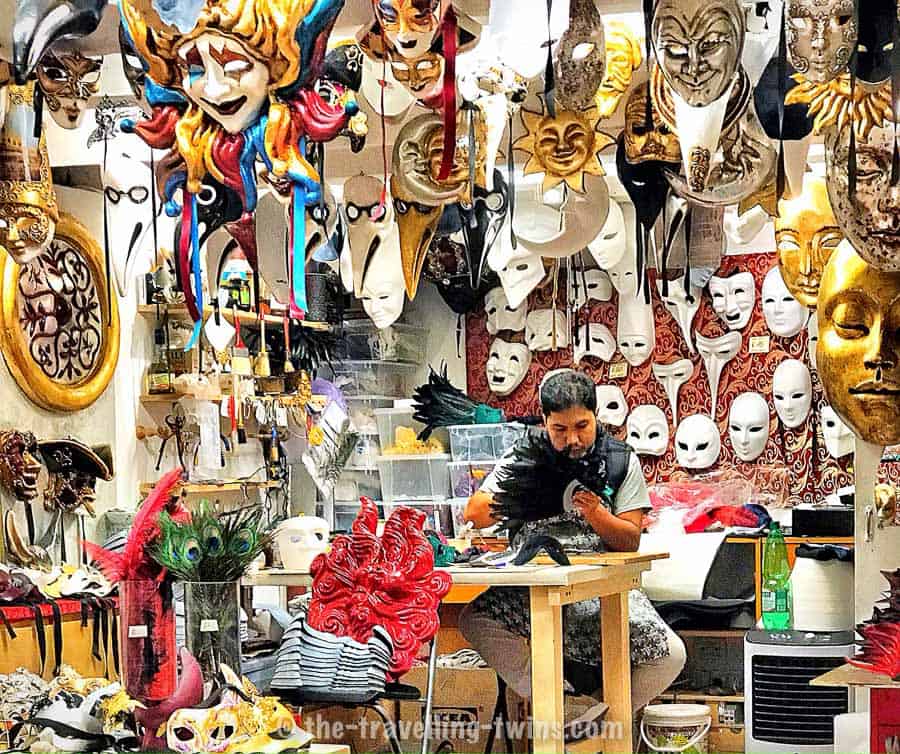
For this reason, there are several mask-making studios in the city where you can visit with your kids and make your own Carnevale mask for souvenirs.
Check the Venice Lido Beaches
Lido is the Italian word for beach, but the Venice Lido is special because it is the 11km sandbar which separates the Venetian lagoon from the Adriatic Sea.. This island is home to 20,000 residents today and was once home to the Venetian Doge. The beaches face out towards the Adriatic and are mostly privately occupied by beach clubs where you can rent beach wares such as chairs and umbrella. However, there are two large free beaches at the northern and southern ends try that on the Gran Viale Santa Maria Elisabetta close to the Vaporetto stop.
Visit Libreria Acqua Alta
Libreria Acqua Alta might just be the most peculiar bookshop in the world. It features a full sized gondola and several other boats and bathtubs piled high with books. There is a staircase in the rear courtyard also made of books, leading to a nice view of one of the canals. There are several cats living in the shop. A sign outside proclaims: Don’t bring your dog into the shop, our cats don’t like them. It a perfect place to visit with kids as they can browse the books, play with cats and escape through the back door of one of the rooms to sit in a moored boat on the water. Our kids love this place and we had come back there again.
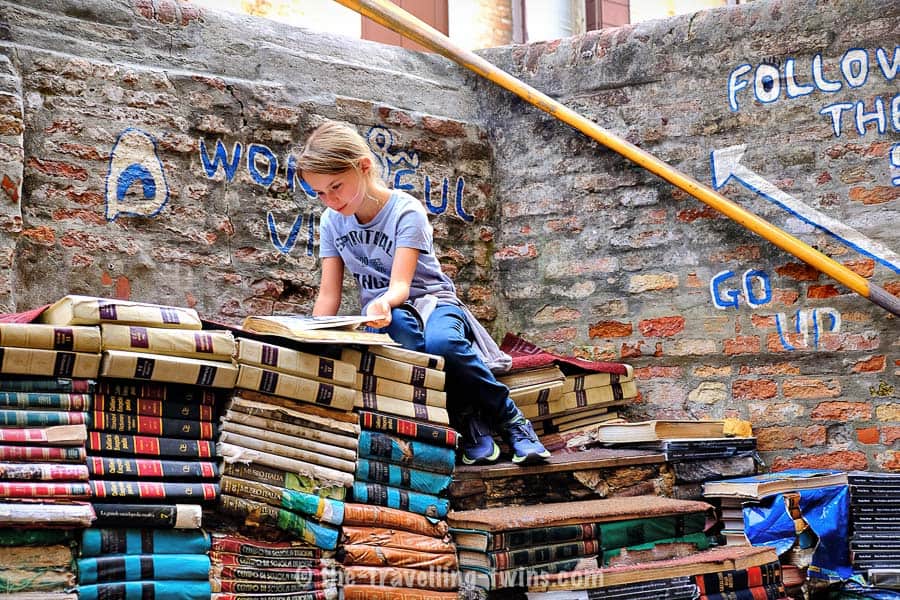
Ride a Gondola
The iconic gondolas can seat up to six people, and watching them navigate along waterways barely wider than the beam of the boat and under bridges so low that the gondolier has to duck low is a great way of passing time in the city. If you fancy hiring one yourself expect to pay more than 80 euro an hour for a gondola ride. We thought it was more fun to watch them from the footways and bridges.
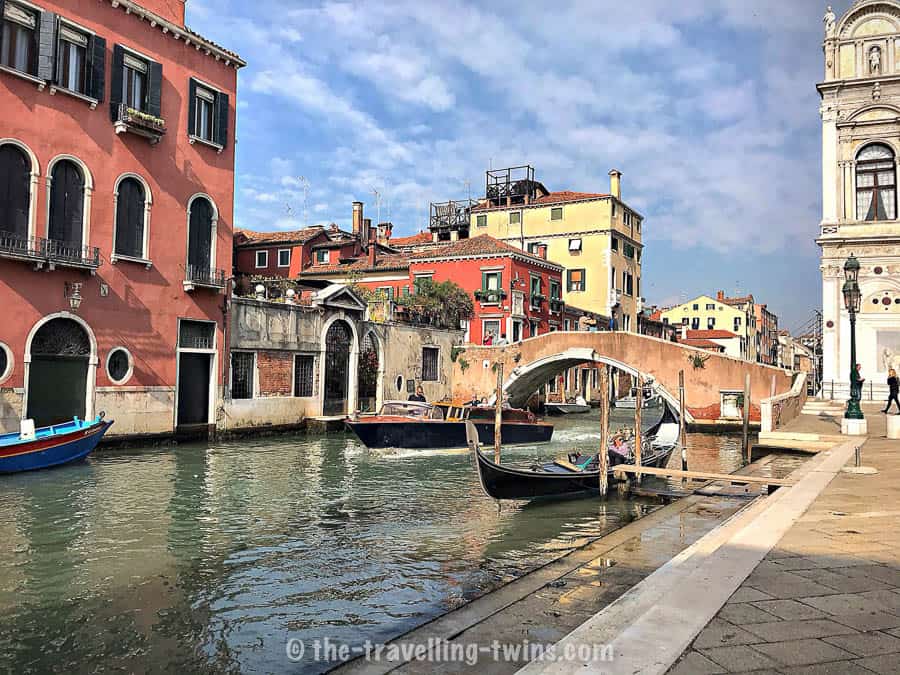
Window Shopping and Souvenir Shopping
On our walks through the town we couldn’t avoid being impressed by the shop windows. Any random pedestrian route through the town presents you with a mixture of stunning modern Italian fashion, beautiful craftsmanship and delicious food. The two most memorable forms of craftsmanship are handmade blown glass ornaments, and masks. The masks come in every imaginable design from classic carnival type (often with beaks and feathers) to steampunk cyborgs involving brass monocles and mysterious flexible tubes The most engaging glassware for our Venice kids were tiny insects and molluscs, beautifully crafted and each seeming to have a very living personality.
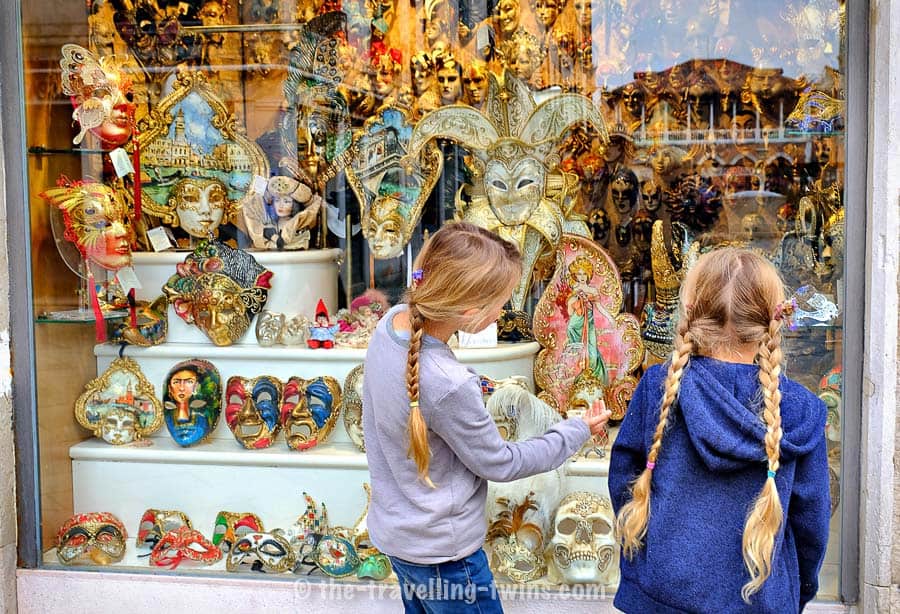
Best Areas to Stay in Venice
When we visited Venice we were on our camper tour from Slovenia, so we stayed in a camper park San Giuliano Venice on the mainland and took a morning shuttle ferry into the city (adults 10 Euro return, kids free). The downside of that was that the ferry lands in the north east of the city, more than 2km as the crow flies from St Marks and double that distance on foot. St Mark’s Square was already crowded by the time we reached it.
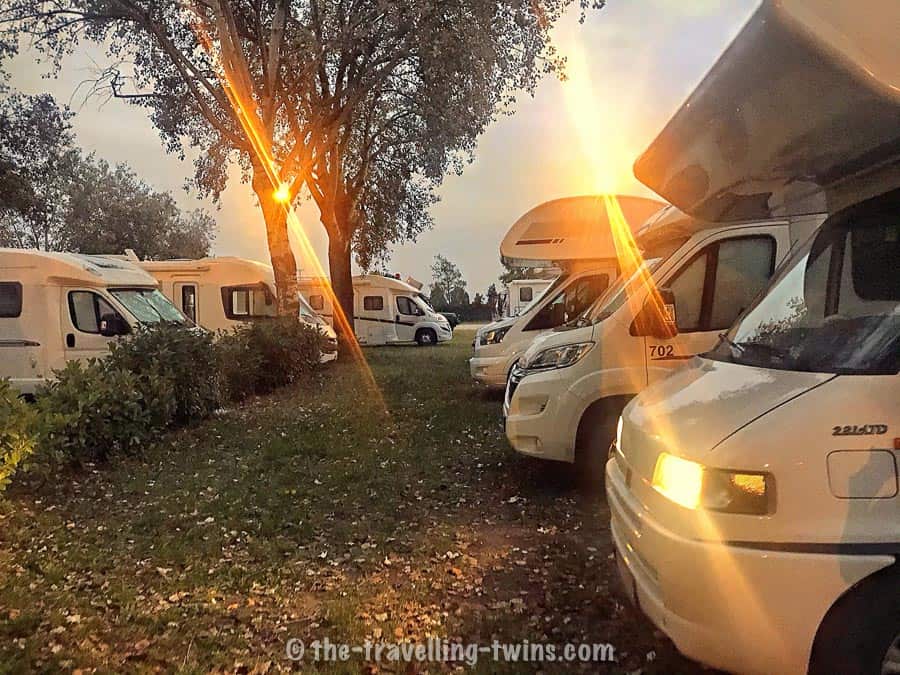
We love our van life trip, but we’re have also researched the best places to stay on islands of the city proper. There are 5 best neighborhoods in the city where you can stay to be closer to the attractions..
Dorsoduro
Situated across the Grand Canal to the west of San Marco and served by Accademia Bridge and lots of Vaporetto stops, it’s easy to fall in love with this area the moment you set your foot there. Dorsoduro exudes some type of young, artsy vibe with its picturesque townscape. The hotels in this area are affordable perhaps because the university is just nearby.
Good family Hotels to stay Nani Mocenigo Palace and Villa Maravege
There are also plenty of places to eat in this neighborhood with an abundance of simple and sensibly priced osterias.
The best things to do here…
Head over to the eastern tip of Dorsoduro and at the edge of Punta della Dogana to enjoy the views of “Venetian superhighway”, with gondolas, ferries, water taxis, barges, and large cruise ships navigating past this peninsula with great ease and precision and surprisingly few collisions.
Giudecca
Giudecca is the large island south of Dorsoduro and St Marks and separated from Venice by Giudecca canal. There are no bridges so you will be travelling by water bus to the main tourist areas. The island is another neighbourhood inhabited by the younger residents with a lively vibe of coffee houses and restaurants. It has some of Venice’s most elegant modern building complexes converted from former industrials buildings including Molino Stucky hotel converted from a flour mill and Junghans – a multi-use residential and commercial hub in a former weapons factory.
Family friendly hotels in Giudecca Al Redentore Di Venezia and Hilton Molino Stucky Venice
The best things to do here…
Giudecca is a haven of peace compared with the main block of the city on the other side of the water, Even if you are not staying here it makes a good contrast for some calm meanderings. Giudecca has numerous beautiful churches and the Casa dei Tre Oci gallery which is among the highest rated of all Venice’s attractions.
San Polo
This neighbourhood, right in the middle of the city is one of the oldest in Venice and it is easy to sense that ancient vibe, just by looking at the maze of buildings. Situated to the north of St Marks across the Grand Canal it is accessible across the Rialto Bridge. Stay in this neighbourhood and expect to get lost – not once or twice but many times. Many fascinating small alleys and lanes lead you into the maze and then abruptly end at a canal.
Family Friendly hotel in San Polo: Polo’s Treasures and Hotel L’Orologio Venice
The best thing to do here…
San Polo is a great district to take a gondola ride, the canals are narrow, the bridges low and the turns tight. These waterways test your gondolier to the limits and also these waterways are less trafficked so you get the fun of the trip while seeing more of the locality and less of your fellow travellers.
Cannaregio
Venice’s most populous neighbourhood, running along the north coast of the cluster of islands that make up the city. Cannaregio is a great place to stay if you plan on using the train as Santa Lucia railway station is at the western edge of the district. The district has plenty of vacation rentals and, hotels, and B&B. Cannaregio is packed with florists, greengrocers, butchers, and bakers So if you are self catering you can hone your own Italian foodie cooking skills with local ingredients.
Family Friendly hotels in Cannaregio: Hotel Palazzo Abadessa and MyPlace Ca D’oro Family Apartment
The best thing to do here…
Visit the cemeteries of Isola di San Michele where the dead are buried over water. In Italian tradition, the dead should be buried outside town, and since Venice is made up of islands, The Venetians created floating cemeteries. These are located across the water to the north of the Cannaregio district
Castello
Castello district is a large area running east from San Marco and along what would be the north eastern peninsula if Venice was all one big island. It offers a more serene environment than most of the parts in the city other than Giudecca . The district has numerous high-end hotels overlooking the canals that separate the island from San Marco.
Family friendly hotels in Castello: Charming House Iqs and B&B Ca’ Furlan
The best thing to do here…
If you are staying this close to San Marco, then get there very early to avoid the crowds and catch the beautiful morning light.
The Best Time to Visit Venice with Kids
Venice is one of the most popular tourist destinations in the world, and very restricted in area. This means it is ridiculously crowded during summer. It is also very cold in winter, and frequently flooded. So to enjoy a trip with kids to Venice, your best option is to schedule your trip in the shoulder months April and May, or October and November. We visited Venice in October and it was perfect, still warm and not too crowded with people.
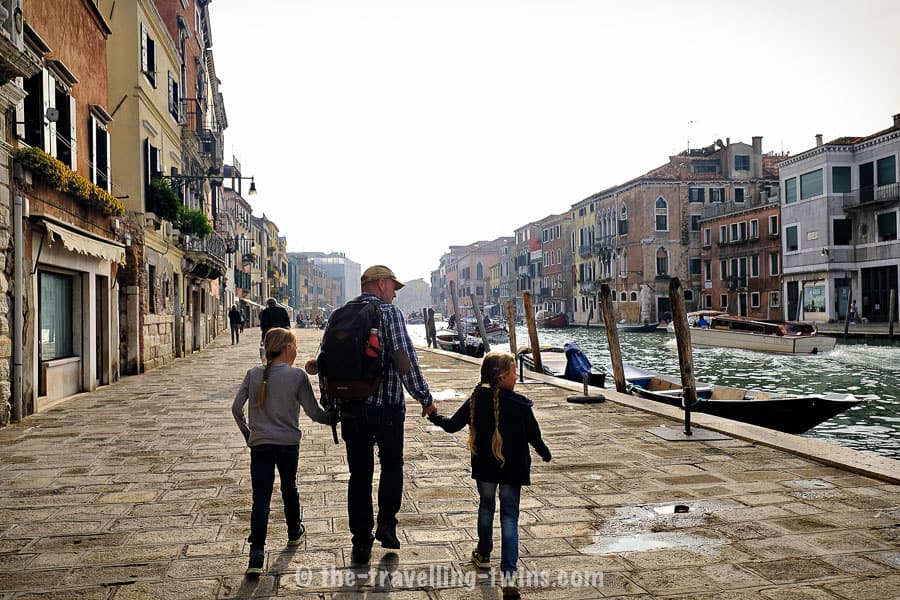
Venice is generally a family-friendly city, but it can be challenging for a family with toddlers. Venice does not have smooth paving or paths for pushing strollers, so if your children are too young to do most of the walking themselves. you will have to carry them every time they get tired. It is also difficult to find changing rooms.
Tips to Save Money in Your Trip to Venice
Tip 1: Don’t stop for a coffee in Piazza San Marco
There are plenty of cafes and trattorias for snacks and food in Venice. While they are still relatively expensive, when it comes to food at St. Marks , the prices are usually unnecessarily expensive.
Tip 2: Go Church-hopping
Yep, that is a thing in Venice. The most famous church in Venice is by far St. Mark’s Basilica, but if you are watching the city skyline; as you navigate the maze, you will notice plenty of towers and gables with crosses on top. Some of the churches charge a small fee while others are completely free, and when it comes to a family vacation, free is a very good price.
Tip 3: Get a Venice Discount Card for transportation
Venice is probably one of the best cities in the world to use a discount card for transportation. After the initial excitement of wandering through tiny alleys, you might find yourself spending more money on Vaporetto tickets than you will on entry fees to museums and other attractions, so getting a discount card for transportation can be a wise choice.
Here you will find Venice Official City Pass
Visit in Venice was the begining of our adventure in Italy. From there we travel in our camper along Adriatic see towards Puglia.
Visiting Venice with kids – share it, Pin it for later

Privacy Policy Disclaimer
This website uses affiliate links for income and support.
If you like our website, please consider using these links. You will be directed to the vendor, and we will get a small commission on your purchase price at no increased cost to you.
We have researched facts stated here as far as practicable but please check anything critical before committing your time and money. We do not claim any special knowledge or expertise, and we are not consultants for our readers.